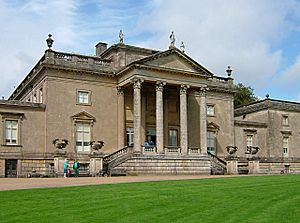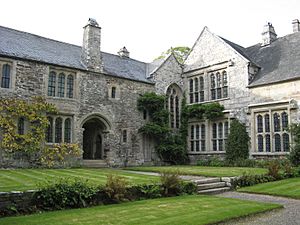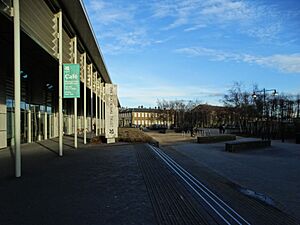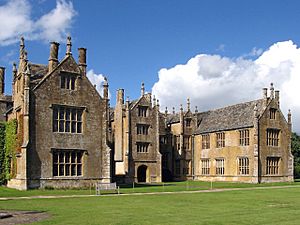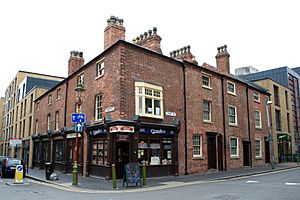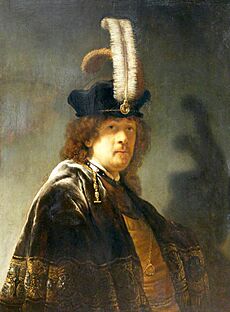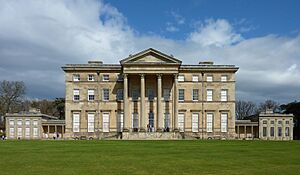National Trust facts for kids
|
Ymddiriedolaeth Genedlaethol (Welsh)
|
|
 |
|
| Established |
|
|---|---|
| Legal status | Statutory corporation |
| Purpose | To look after Places of Historic Interest or Natural Beauty permanently for the benefit of the nation across England, Wales and Northern Ireland |
| Headquarters | Heelis, Swindon, Wiltshire, England |
|
Region served
|
England, Wales and Northern Ireland |
|
Membership
|
5.38 million (2023/24) |
|
Key people
|
|
|
Main organ
|
Board of trustees |
|
Revenue
|
£723.8 million (2023/24) |
|
Staff
|
14,000 |
|
Volunteers
|
53,000 |
The National Trust is a special charity in England, Wales, and Northern Ireland. It works to protect and care for important historical places and beautiful natural areas.
The Trust started in 1895. Three people, Octavia Hill, Sir Robert Hunter, and Hardwicke Rawnsley, wanted to save beautiful lands and historic buildings for everyone to enjoy forever. Over time, the Trust gained special powers from the government to help it do this.
Today, the National Trust is one of the biggest landowners in the United Kingdom. It owns nearly 250,000 hectares (about 617,000 acres) of land and 780 miles of coastline. This includes over 500 historic houses, castles, gardens, parks, and nature reserves. Most places are open to the public, and members can visit for free. The Trust earns money mainly from membership fees, donations, and its shops and restaurants.
Contents
History of the National Trust
How the Trust Began
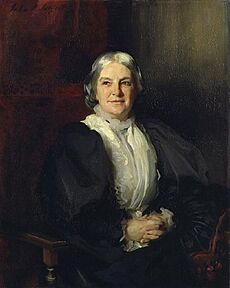
The National Trust officially began on January 12, 1895. Its full name is "The National Trust for Places of Historic Interest or Natural Beauty." The founders were Octavia Hill, a social reformer; Sir Robert Hunter, a lawyer; and Hardwicke Rawnsley, a clergyman.
Before the Trust, Octavia Hill had already started a group to help people enjoy beautiful places. Robert Hunter worked to protect common lands, and Hardwicke Rawnsley fought to save the Lake District. They all shared a dream: to create an organization that could buy and protect important buildings and lands.
In 1894, these founders met and decided on the name "National Trust." They officially registered the Trust in 1895. Their goal was to "promote the permanent preservation for the benefit of the Nation of lands and tenements (including buildings) of beauty or historic interest."
Early Days and First Properties
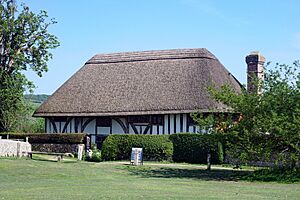
The Trust got its first piece of land in 1895. It was Dinas Oleu, a clifftop area in Barmouth, Wales, given by Fanny Talbot. The very first building the Trust bought was Alfriston Clergy House in Sussex in 1896. It was a 14th-century house that needed a lot of repairs.
In 1907, the first National Trust Act was passed by Parliament. This law gave the Trust special power to declare its land "inalienable." This means the land cannot be sold without Parliament's approval, ensuring it is protected forever. More laws followed in later years, giving the Trust even more powers.
In its early years, the Trust focused on saving open spaces and smaller threatened buildings. One of its first large country houses was Barrington Court in Somerset. The Trust also acquired important nature sites like Wicken Fen and Blakeney Point. By 1914, the Trust had 725 members and owned 63 properties, covering about 5,814 acres.
Growing Bigger
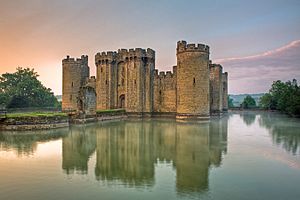
After 1920, the Trust continued to grow. Gifts of land were made in memory of founder Hardwicke Rawnsley, especially in the Lake District. Under the new chairman, John Bailey, the Trust gained more money, members, and properties.
In the 1920s, the Trust acquired more ancient sites and medieval castles, like Bodiam Castle and Tattershall Castle, Lincolnshire. In 1925, the Trust raised a record £80,000 to buy the Ashridge Estate. John Bailey was praised for his "persuasive enthusiasm" in helping the Trust grow.
The Trust also started protecting more coastal areas in the 1930s. In 1934, it acquired its first entire village, West Wycombe in Buckinghamshire. Later, Quarry Bank Mill in Cheshire, a historic factory, was donated along with the village of Styal, which was built for the mill workers.
During the 1930s and 1940s, a secret group of women called "Ferguson's Gang" helped the Trust by raising money in fun and unusual ways. Their donations helped the Trust buy properties like Shalford Mill and Newtown Old Town Hall.
Saving Country Houses
In 1936, the Trust created a special plan to save large country houses and their gardens. Many owners could no longer afford to keep these huge homes. The plan allowed owners to give their houses to the Trust. They could still live there, and their families could too, as long as the public was allowed to visit sometimes. This also helped owners with taxes.
The first house offered under this plan was Stourhead in Wiltshire. The first house actually handed over was Wightwick Manor near Wolverhampton. Another early acquisition was Lacock Abbey in Wiltshire, which came with the village of Lacock.
After World War II
After World War II, the government created the National Land Fund. This fund helped the Trust acquire historic houses and land that were given to the government instead of taxes. Cotehele in Cornwall was one of the first country houses acquired this way. Other important places like Hardwick Hall and Penrhyn Castle also joined the Trust.
Between 1945 and 1965, the Trust grew a lot. Its membership jumped from 7,850 to over 157,000, and the land it owned increased significantly. In 1959, the Trust even helped restore a section of the Stratford-upon-Avon Canal with the help of many volunteers.
Modern Times
The end of the 20th century saw a huge increase in National Trust membership, reaching over two million by 1995. The Trust started opening tea rooms and souvenir shops at its properties. It also began organizing events like plays, concerts, and educational activities.
In the 21st century, the Trust continued to acquire important properties. In 2002, it bought Tyntesfield, a large Victorian mansion. In 2005, the Trust moved its main office to Heelis in Swindon, a modern building designed to be environmentally friendly. The building is named after Beatrix Potter, a famous children's author who supported the Trust and donated land.
The Trust has also been looking into the history of its properties, including their connections to colonialism and historic slavery. This research helps them tell a more complete story about these places.
How the National Trust is Run
| National Trust Act 1907 | |
|---|---|
| Act of Parliament | |

|
|
| Citation | 7 Edw. 7. c. cxxxvi |
| Dates | |
| Royal assent | 21 August 1907 |
| Text of statute as originally enacted | |
| National Trust Charity Scheme Confirmation Act 1919 | |
|---|---|
| Act of Parliament | |

|
|
| Citation | 9 & 10 Geo. 5. c. lxxxiv |
| Dates | |
| Royal assent | 15 August 1919 |
| National Trust Act 1937 | |
|---|---|
| Act of Parliament | |

|
|
| Long title | An Act to confer further powers upon the National Trust for Places of Historic Interest or Natural Beauty and for other purposes. |
| Citation | 1 Edw. 8 & 1 Geo. 6. c. lvii |
| Dates | |
| Royal assent | 1 July 1937 |
| Text of statute as originally enacted | |
| National Trust Act 1939 | |
|---|---|
| Act of Parliament | |

|
|
| Long title | An Act to make further provision with respect to the transfer of lands to the National Trust for Places of Historic Interest or Natural Beauty and for other purposes. |
| Citation | 2 & 3 Geo. 6. c. lxxxvi |
| Dates | |
| Royal assent | 28 July 1939 |
| National Trust Act 1953 | |
|---|---|
| Act of Parliament | |

|
|
| Long title | An Act to amend the National Trust Acts 1907 to 1939 to confer further powers upon the National Trust for Places of Historic Interest or Natural Beauty and upon the council thereof and for other purposes. |
| Citation | 1 & 2 Eliz. 2. c. vii |
| Dates | |
| Royal assent | 6 May 1953 |
| Text of statute as originally enacted | |
| National Trust Act 1971 | |
|---|---|
| Act of Parliament | |

|
|
| Long title | An Act to amend the constitution of the National Trust for Places of Historic Interest or Natural Beauty; to amend the National Trust Acts 1907 to 1953; to confer further powers on the said National Trust; and for other purposes. |
| Citation | 1971 c. vi |
| Territorial extent |
|
| Dates | |
| Royal assent | 17 February 1971 |
| Text of statute as originally enacted | |
| Charities (National Trust) Order 2005 | |
|---|---|
| Statutory Instrument | |

|
|
| Citation | SI 2005/712 |
| Dates | |
| Made | 11 March 2005 |
| Commencement | 25 March 2005 |
| Other legislation | |
| Amends |
|
| Made under | Charities Act 1993 |
| Text of statute as originally enacted | |
The National Trust is an independent charity. It was first set up as a company in 1895. Later, special laws passed by Parliament, like the National Trust Act 1907, gave it unique powers. These laws have been updated over the years to help the Trust do its work.
The Trust is managed by a group of people called trustees. There are between nine and fifteen trustees. They are chosen and watched over by a council. This council has 18 people elected by Trust members and 18 people chosen by other related organizations.
The Trust's main office is in Swindon. It also has regional offices across the UK. In 2019/20, the Trust had 14,000 staff members, including many who work during busy seasons.
Funding the Trust
In 2023/24, the National Trust's income was about £724 million. Most of this money comes from people who pay to be members. Other income comes from property visits and sales in shops and cafes.
The Trust also receives grants from government departments and other charities. For example, it gets money from the National Lottery Heritage Fund. To thank lottery players, the Trust often lets lottery ticket holders visit some properties for free on certain days. It also takes part in Heritage Open Days, when non-members can visit selected places for free.
Membership and Volunteering
In the year ending February 2024, the Trust had 5.38 million members. Members get free entry to most Trust properties that usually charge a fee. There is also a separate group called the Royal Oak Foundation for supporters in America.
Many people help the Trust by volunteering their time. In 2024, about 40,000 volunteers supported the Trust's work.
National Trust Properties
As of 2020, the Trust owns almost 250,000 hectares (about 617,000 acres) of land and 780 miles of coastline. It also cares for over 200 historic houses, 41 castles, 47 industrial sites, 9 lighthouses, 56 villages, and 39 pubs. Much of the land is used for farming. The Trust also rents out holiday cottages.
Historic Houses and Gardens
The Trust owns more than 200 historic houses that are open to the public. Many are large country houses with beautiful gardens and parks. These houses often contain original art, furniture, books, and other items.
Attingham Park in Shropshire was one of the most visited country houses in 2019/20. It has a walled garden and large parkland. Clumber Park in Nottinghamshire was the most visited property that charges admission, even though its main house was mostly taken down in 1938. It has a chapel, a lake, and beautiful grounds.
The Trust acquired most of its country houses in the mid-20th century. At that time, many owners could no longer afford to keep their large homes. The Trust's agreements often allowed families to continue living in the houses. Since 2000, the Trust has acquired fewer large houses, with Tyntesfield and Seaton Delaval Hall being two recent examples.
Besides grand country houses, the Trust also owns smaller properties. Many of these are linked to famous people. For example, Cherryburn was the home of artist Thomas Bewick. Smallhythe Place was the home of actress Ellen Terry. Shaw's Corner was where writer George Bernard Shaw lived.
The Trust also owns 2 Willow Road in London, which was the home of architect Ernő Goldfinger. It was the first modern-style house the Trust acquired. In 1995, the Trust bought 20 Forthlin Road in Liverpool, the childhood home of Paul McCartney. 251 Menlove Avenue, John Lennon's childhood home, was donated to the Trust in 2002. The Birmingham Back to Backs show what working-class homes looked like in the past.
Some properties have special arrangements. For example, Wakehurst Place is managed by the Royal Botanical Gardens, Kew.
Art Collection
The National Trust has a large collection of art. Most of these artworks came with the properties the Trust acquired. The collection includes paintings, sculptures, and other items.
Famous artists like Rembrandt, Hieronymous Bosch, El Greco, and Peter Paul Rubens are represented in the Trust's collections. For example, a self-portrait by Rembrandt is displayed at Buckland Abbey.
Since 2009, the Trust has run a program called "Trust New Art." It works with modern artists to create new artworks inspired by Trust places. Over 200 artists have been part of this program, including Jeremy Deller and Antony Gormley.
Coastline and Countryside Protection

The National Trust is the biggest private landowner in the United Kingdom. Most of its land is countryside. A large part of this land is made up of parks and farms connected to country houses. However, many countryside properties were bought specifically for their beautiful views or scientific importance. The Trust owns about a quarter of the Lake District and about 12% of the Peak District National Park.
Most of the Trust's land, about 200,000 hectares (about 494,000 acres), is used for farming. People can usually access these areas through public paths. The Trust also owns forests, woods, hills, and moorland. These areas are generally free for the public to visit.
The Trust owns or protects about one-fifth of the coastline in England, Wales, and Northern Ireland (780 miles). It has a long-term project called Project Neptune to acquire even more coastline.
Protecting Trust Property
The National Trust has a special power from the National Trust Act 1907. It can declare land "inalienable." This means the Trust cannot sell or mortgage this land on its own. This rule helps protect the land forever.
Special laws also protect inalienable land from being bought by the government against the Trust's wishes. If the Trust objects, Parliament must approve the purchase. This makes it very difficult for these protected lands to be taken away.
For example, in 2017, the Trust supported a plan to build a road tunnel under the Stonehenge World Heritage Site. This plan would involve buying some land held by the Trust.
Most Visited Properties
Here are the top ten most visited National Trust properties that charge an admission fee, based on the Trust's 2022–2023 report:
| No. | Property | Location | Visitors |
|---|---|---|---|
| 1 | Attingham Park | Shropshire | |
| 2 | Clumber Park | Nottinghamshire | |
| 3 | Dunham Massey Hall | Greater Manchester | |
| 4 | Cliveden | Buckinghamshire | |
| 5 | Calke Abbey | Derbyshire | |
| 6 | Fountains Abbey | North Yorkshire | |
| 7 | Stourhead | Wiltshire | |
| 8 | Belton House | Lincolnshire | |
| 9 | Tyntesfield | Somerset | |
| 10 | Kingston Lacy | Dorset |
Images for kids
See also
 In Spanish: Fundación Nacional para Lugares de Interés Histórico o Belleza Natural para niños
In Spanish: Fundación Nacional para Lugares de Interés Histórico o Belleza Natural para niños
- An Taisce and the Irish Heritage Trust (Republic of Ireland)
- English Heritage, a similar charity that manages places of historic interest in England
- Historic Houses Association
- Landmark Trust
- List of National Trust properties in England
- List of National Trust properties in Northern Ireland
- List of National Trust properties in Wales
- National Trust (typeface)
- National Trust for Scotland
- Manx National Heritage (equivalent body for the Isle of Man)


